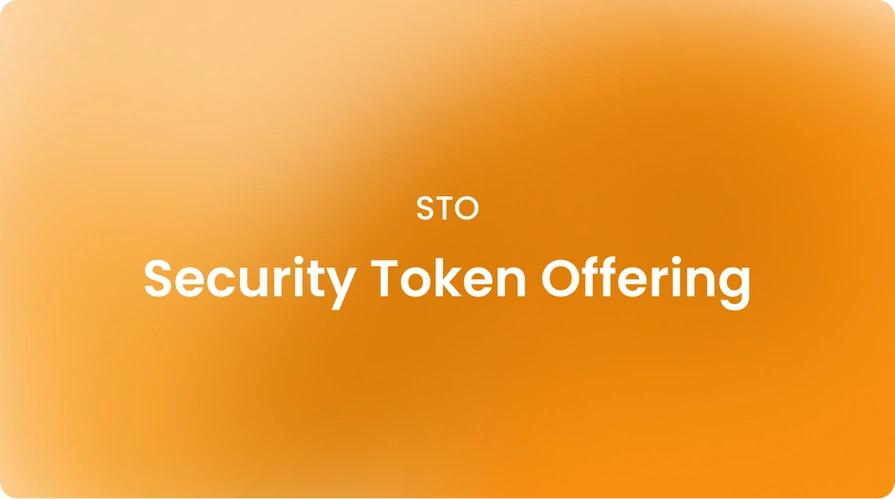|crypto, knowledgehub
The Ultimate Comparison Between ICO and STO

As blockchain technology becomes more prevalent, new forms of fundraising have emerged on this innovative platform. Initial coin offerings (ICOs) and security token offerings (STOs) are two such methods that have enabled startups to raise capital in recent years.
While both have similarities in their use of crypto tokens, there are important distinctions between ICO and STO in their structure, target participants, and regulation. Let’s take a deeper dive into these new fundraising models and learn the basics of each!
What is an ICO?
An initial coin offering (ICO) refers to a means of crowdfunding through the issuance and distribution of digital tokens on a blockchain in exchange for funding raised.
In an ICO, a company issues a new crypto coin or token and sells a portion of these tokens to early backers of the project in exchange for other major cryptocurrencies. This new crypto token is typically used on whatever platform or service the startup is focused on building.
Understanding ICOs
In an ICO, a company announces plans to build a new product or platform and sells digital tokens to raise funds for development. These tokens may be exchanged for services once the project launches, but they carry no equity stake.
Buyers hope token values rise as the network expands. While ICOs can raise large sums quickly, their lack of oversight means investors have little recourse if projects fail to deliver or funds go missing.
The advantages of an ICO
ICOs can launch more quickly and with lower upfront costs by avoiding securities registration. This open process theoretically allows any interested party globally to participate.
The publicity may also help spread awareness of a new project early on. Successful ICOs, such as Ethereum, demonstrated how much capital ambitious blockchain startups could raise through this model.
The disadvantages of ICO
Many early initial coin offerings lacked oversight and transparency, which led to numerous scams and the misuse of funds with no recourse for buyers.
Most ICO tokens fell well short of providing the returns promoters advertised. Various government regulators worldwide have since declared the majority of ICO tokens to be securities, requiring compliance with securities laws, which was not possible retroactively.
What is an STO?
A security token offering (STO) refers to a regulated method of fundraising where a company issues digital tokens verified as securities. This means STO tokens are recorded on public blockchain ledgers like Ethereum but must comply with securities laws.
The tokens represent real-world assets, such as company shares, and provide owners with traditional shareholder rights. To understand STO better, make sure to check out “security tokens”.
Understanding STOs
In an STO, a blockchain project launches security tokens instead of utility tokens or payment tokens. Similar to stocks, STO tokens are equity investments that give owners legal ownership of company assets and voting rights.
This subjected STOs to regulatory oversight to protect investors. Accredited investors must fund and undergo KYC/AML checks. Projects must also provide regular financial disclosures and abide by securities trading rules, such as crypto travel rules.
The advantages of STO
STOs provide more robust transparency and oversight that were largely absent from early ICOs. Investors gain shareholder rights, such as voting and access to financial reports.
Cryptobunq is a crypto-friendly digital bank offering various services in crypto and blockchain, like custody and trading for STOs. You can benefit from custody and wallet, crypto exchange API, crypto checkout and invoicing, tokenization, batch crypto payments, and more with Cryptobunq.
The disadvantages of STO
STO faces higher regulatory hurdles, which increase legal compliance costs and limit the pool of eligible investors to only wealthy accredited individuals. The more restrictive framework also reduces the total funds that can be raised compared to an open ICO.
The verification process may also take longer, which risks losing the "first-mover advantage" to competitors in a fast-moving blockchain market.
How do ICO and STO work?
In an ICO, developers create a unique digital currency or token and make it available for the public to purchase, often in exchange for Bitcoin or Ether. There is typically no limit on who can participate.
STOs function similarly to traditional equity crowdfunding. Projects only raise money from accredited investors after verifying their identity and status. Investors receive digital tokens recorded as securities on the blockchain that represent the company's equity.
How do regulatory changes impact ICOs and STOs?
Regulators globally have clearly stated that they will regulate any digital asset that meets the economic reality of an investment contract as a security. This destroyed the viability of open ICOs, as now “utility tokens” must meet securities law standards before being sold.
Meanwhile, regulatory clarity on crypto token classification kicked off the STO market for projects willing to submit to oversight in exchange for legitimizing crypto fundraising. Regulations evolving have reshaped both markets to focus on verified investors.
What role does transparency play in ICOs and STOs?
Transparency is crucial for both models to function properly and avoid scams. However, ICO had little accountability, which damaged confidence.
STOs add layers of oversight through policies like accredited-only access, KYC/AML checks, and ongoing disclosure demands that reassure investors that funds are handled safely and projects are legitimate.
With STOs, crypto services from companies like Cryptobunq also bring transparency through tools that securely store, track, and trade digital assets according to securities regulations.
How is STO different from an ICO?
While ICO and STO both use blockchain technology to issue digital tokens, STOs are structured as regulated securities required to represent ownership in the issuing entity. This subjects them to existing securities laws and provides investors with protections like those of traditional equity financing.
ICOs issue unregulated utility or payment tokens and lack the shareholder rights or legal safeguards that STOs feature. Eligibility is also limited to accredited investors with STOs rather than any individual with an ICO.
Can anyone invest in ICOs and STOs?
ICOs are generally open to the public worldwide, while STOs may only be offered to accredited or experienced investors meeting defined income or net worth minimums set by securities regulators.
This is intended to limit risk to sophisticated parties who are better able to assess investments and bear potential losses. Non-accredited individuals may still access STO projects as tokens are typically later traded on secondary markets, though the regulation of exchanges also differs by jurisdiction.
What to choose: ICO or STO?
ICOs provide an avenue for projects to secure extensive funding and reach a global audience. But STOs reduce the risk of legal issues down the road under today's more stringent global regulations while still raising substantial sums. STOs also provide investors with transparency.
The secure and transparent handling of digital assets by Cryptobunq make STOs an attractive crypto fundraising choice for companies serious about compliance and building long-term, trusted relationships with their customers, investors, and regulators.
Blockchain and the future of ICOs and STOs
As government policies evolve alongside technology, both ICO and STO will change further. Regulations adapting could unlock blockchain's potential to streamline global capital raising. Harmonizing frameworks across borders may expand investor pools for STOs.
Furthermore, ICOs may incorporate more protections to balance oversight and accessibility. With experience, projects will optimize each model's advantages in fundraising while mitigating inherent risks.
The bottom line
While both ICO vs STO utilize blockchain technology, STOs add important legal protections and transparency for investors that early ICOs often lacked.
With regulation taking a firmer stance on investor protection, STOs appear positioned to unlock further growth opportunities while enabling compliant funding of new blockchain ventures. The future remains bright as innovations respond dynamically to the realities of this fast-evolving landscape.
Transparent and secure services from companies like Cryptobunq show how blockchain can revolutionize capital markets worldwide through trusted digital securities. Check our case studies and contact us today and explore the expert crypto and blockchain services for your various projects!













